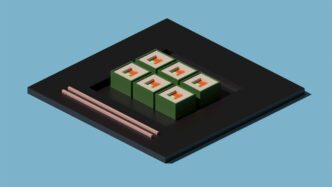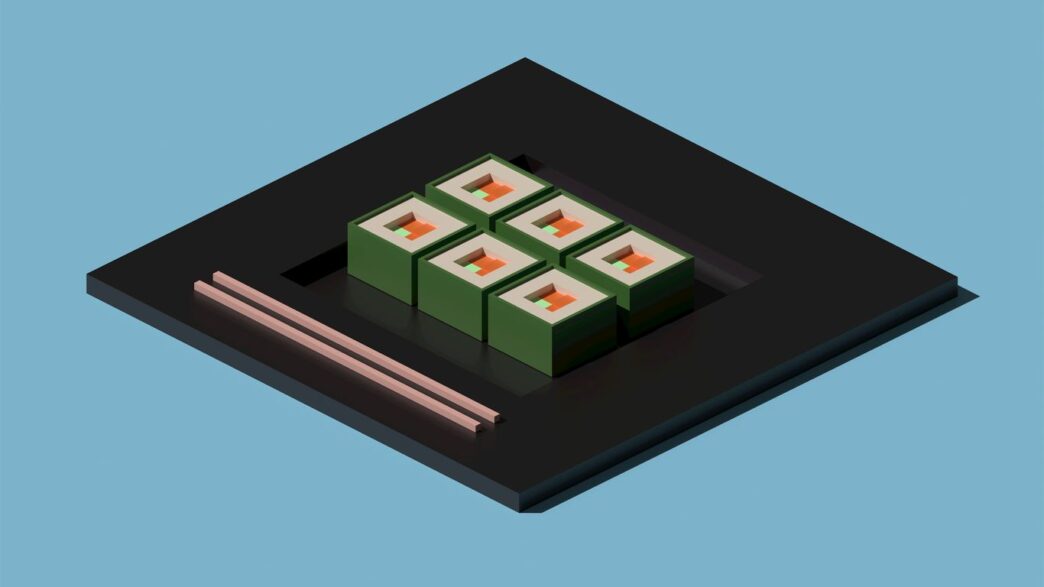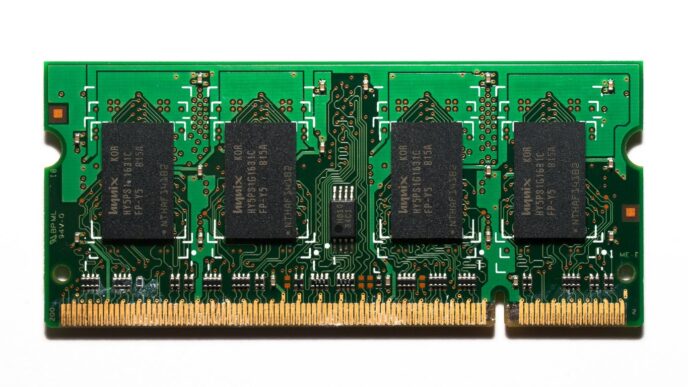It seems like every other week there’s some big news about quantum computers. This time, it’s China making a splash with their Zuchongzhi 3.0 processor. They’re saying it’s incredibly fast, like, a quadrillion times faster than what we have now. It’s a pretty big deal, especially when you think about what this could mean for science and technology down the road. Let’s break down what this Zuchongzhi 3.0 thing is all about and why it matters.
Key Takeaways
- China has developed a new quantum processor, Zuchongzhi 3.0, featuring 105 superconducting qubits.
- This quantum computer china is reported to be a quadrillion times faster than current top supercomputers for specific tasks.
- The Zuchongzhi 3.0 has demonstrated significant speedups on the random circuit sampling benchmark, outperforming previous results from Google.
- Advancements in coherence time, gate fidelity, and error reduction are key to its improved performance.
- This development signifies a major step in the global race for quantum computing superiority and has potential implications for fields like cryptography and drug discovery.
China’s Quantum Processor Sets New Speed Records
It feels like every few months, we hear about another big leap in quantum computing, and honestly, it’s getting hard to keep track. But this latest news from China? It’s a pretty big deal. Researchers have rolled out a new quantum processor, the Zuchongzhi 3.0, and they’re saying it’s ridiculously fast. We’re talking about speeds that are a quadrillion times quicker than the most powerful supercomputers we have today. That’s a number so big it’s hard to even wrap your head around.
Zuchongzhi 3.0: A Quadrillion Times Faster
So, what does a quadrillion times faster actually mean? Well, imagine a task that would take the world’s best supercomputer billions of years to complete. Zuchongzhi 3.0 can apparently do it in a matter of seconds. This isn’t just a small improvement; it’s a massive jump. The team at the University of Science and Technology of China (USTC) used a specific test called random circuit sampling to show this off. They claim their processor completed a task that would take the Frontier supercomputer, one of the fastest out there, about 5.9 billion years, in just a few hundred seconds. That’s a speedup of 10<sup>15</sup>, or a quadrillion times. It’s a bold claim, but the numbers are pretty striking.
Superconducting Qubits Drive Unprecedented Performance
How are they achieving these speeds? It all comes down to the hardware. Zuchongzhi 3.0 uses 105 superconducting qubits. These aren’t your average bits in a regular computer; they’re the building blocks of quantum computation, and they can exist in multiple states at once. The design of these qubits, along with improvements in how long they can maintain their quantum state (coherence time) and how accurately operations are performed (gate fidelity), are key. Think of it like building a race car: you need a powerful engine (the qubits), but you also need a finely tuned chassis and suspension to make it truly fast and reliable. They’ve apparently made some serious upgrades to all these parts.
Outperforming Google’s Latest Quantum Chip
This isn’t just about beating supercomputers; it’s also a race between different quantum computing projects. Zuchongzhi 3.0 is being compared directly to Google’s latest quantum chip, Willow. While Google’s chip also made waves with its own speed demonstrations, the USTC team says their processor is about a million times faster on the same kind of benchmark tests. This kind of competition is actually good for the field, pushing everyone to innovate faster and develop even more powerful machines. It’s a complex race, and different chips have different strengths, but Zuchongzhi 3.0 is definitely making a strong statement.
Understanding the Zuchongzhi 3.0 Architecture

So, how does this Zuchongzhi 3.0 actually work? It’s built using superconducting qubits, which are basically tiny circuits cooled down to super cold temperatures. These qubits are the heart of the processor, and their quality really matters for doing any kind of quantum calculation.
105 Superconducting Qubits and Their Design
The Zuchongzhi 3.0 processor packs 105 of these superconducting qubits. They’re arranged in a neat, rectangular grid, kind of like a checkerboard, but with 15 rows and 7 columns. This layout isn’t just for looks; it helps the qubits talk to each other more effectively. They’re connected using special parts called tunable couplers, and there are 182 of them. This setup allows for flexible interactions between qubits, which is pretty important for running complex quantum programs. They also used a neat trick called "flip-chip" bonding, where two chips are stacked face-to-face. This helps pack things tightly and keeps the signals clean, reducing loss. The whole thing sits on a sapphire base, which is good at keeping electrical noise down and staying stable when it’s really cold. This whole design is a step up from earlier versions, aiming for more reliable quantum operations.
Enhancements in Coherence Time and Gate Fidelity
Two big words in quantum computing are "coherence time" and "gate fidelity." Coherence time is how long a qubit can hold onto its quantum information before it gets messed up by the environment. Zuchongzhi 3.0 has improved this, with qubits lasting about 72 microseconds (µs) before their energy relaxes, and 58 µs before they lose their quantum phase. That’s a decent jump, meaning the processor can perform more steps in a calculation before errors creep in. Then there’s gate fidelity, which is basically how accurately the processor can perform operations on the qubits. For single-qubit operations, it’s 99.90% accurate, and for two-qubit operations, it’s 99.62%. While other chips might have slightly higher numbers, these are really competitive and show a lot of progress in making these operations precise. These improvements are key to making quantum computers actually useful for tough problems. You can see how these numbers stack up against other processors in the global quantum computing race.
Minimizing Errors for Greater Accuracy
Quantum computers are naturally prone to errors. It’s like trying to have a quiet conversation in a really noisy room. Zuchongzhi 3.0 has several things going for it to fight these errors. The materials used, like tantalum and aluminum, are chosen to be less sensitive to noise. The careful design of the qubits and couplers also helps reduce unwanted interference. Plus, the improved coherence times and gate fidelities mean fewer mistakes happen during calculations. While they haven’t fully implemented advanced quantum error correction yet, these built-in improvements are a big deal. They allow the processor to run more complex calculations, like the random circuit sampling benchmark, with a higher degree of confidence in the results. It’s all about getting the most accurate answers possible from these incredibly sensitive machines.
Quantum Advantage Demonstrated Through Benchmarking
So, China’s Zuchongzhi 3.0 quantum computer has been doing some serious number crunching, and the results are pretty wild. They ran a specific kind of test called Random Circuit Sampling, or RCS for short. Think of it like this: they set up a random sequence of operations on 83 of the computer’s qubits. This task is designed to be incredibly difficult for regular computers to copy. The Zuchongzhi 3.0 managed to churn out a million results from this complex circuit in just a few hundred seconds. To put that in perspective, the fastest supercomputers out there would apparently need billions of years to do the same thing. That’s a speed difference of about a quadrillion times, which is just mind-boggling.
The Random Circuit Sampling Benchmark
This RCS benchmark is a go-to for showing off what quantum computers can do that classical ones can’t. It’s all about complexity. When you have more qubits and more steps (or ‘depth’) in the circuit, the number of calculations a classical computer needs to do explodes. For Zuchongzhi 3.0’s 83-qubit test, the sheer number of possible outcomes is astronomical, making it practically impossible for even the most powerful supercomputers to keep up. The Zuchongzhi 3.0, however, handles this exponential growth with relative ease, showcasing its quantum edge.
Speedup Compared to Classical Supercomputers
The numbers here are pretty stark. The Zuchongzhi 3.0 completed its RCS task in minutes. The estimated time for a classical supercomputer, like the Frontier system, to perform the same calculation? Around 6.4 billion years. This massive difference, a factor of 10^15, is what scientists mean when they talk about ‘quantum advantage.’ It’s not just a little faster; it’s a whole different league of computation.
Challenges and Nuances in Quantum Supremacy Claims
Now, claiming ‘quantum supremacy’ or ‘quantum advantage’ isn’t as simple as just running a test. Verifying these results is tricky because, by definition, classical computers can’t easily check the quantum computer’s work. The Zuchongzhi 3.0 team used clever methods, like breaking down the big circuit into smaller parts that could be checked classically, to build confidence in their results. They also used statistical checks. While the scientific community generally accepts these findings, especially when published in reputable journals, there’s always a bit of debate about the exact definition and measurement of this advantage. It’s a fast-moving field, and what seems like a clear win today might be met with better classical algorithms tomorrow. So, while Zuchongzhi 3.0’s speedup is impressive, it’s part of an ongoing scientific conversation.
Implications of China’s Quantum Computing Leap
China’s recent quantum computing achievements, particularly with the Zuchongzhi 3.0 processor, signal a significant shift in the technological landscape. This isn’t just about faster calculations; it’s about opening doors to solving problems that were previously out of reach for even the most powerful traditional computers. Think about things like designing new medicines or creating unbreakable codes – these are the kinds of complex challenges that quantum computers are expected to tackle.
Revolutionizing Fields Like Cryptography and Drug Discovery
The sheer processing power demonstrated by Zuchongzhi 3.0 means we’re getting closer to a future where certain scientific and security problems can be solved in ways we can’t even imagine today. For instance, in drug discovery, quantum computers could simulate molecular interactions with incredible accuracy, speeding up the development of new treatments. In cryptography, the implications are twofold: while quantum computers could break current encryption methods, they also pave the way for new, quantum-resistant security protocols. This dual impact means a significant overhaul of our digital security infrastructure might be on the horizon.
Laying the Groundwork for Future Innovations
What Zuchongzhi 3.0 represents is more than just a single powerful machine. It’s a stepping stone, a clear sign that the fundamental building blocks for more advanced quantum systems are falling into place. The research and development happening now, like the work at China’s National Laboratory for Quantum Information Sciences, are building the foundation for technologies that will shape industries for decades to come. It’s like laying the tracks for a high-speed train – the train itself is impressive, but it’s the infrastructure that makes widespread use possible.
The Growing Importance of Quantum Supremacy
When we talk about
The Global Quantum Computing Race
The development of quantum computers isn’t just a scientific pursuit; it’s become a major point of competition between nations, especially between China and the United States. It’s kind of like the space race back in the day, but instead of rockets, we’re talking about processing power and the ability to solve problems that are currently impossible for even the biggest supercomputers. This race is about more than just bragging rights; it’s about future economic power and national security.
Competition Between China and Other Leading Nations
Right now, China and the U.S. are definitely the two main players, trading blows with new breakthroughs. The U.S. had an early win with Google’s Sycamore chip back in 2019, claiming they’d reached ‘quantum supremacy.’ But China didn’t just sit back. They’ve come out with their own impressive machines, like the Zuchongzhi processors, showing they can do amazing things too, especially with their latest Zuchongzhi 3.0. It’s a constant back-and-forth, with each side announcing new achievements that keep everyone watching closely. Other countries and big tech companies are also investing heavily, but the U.S. and China seem to be setting the pace.
National Strategies and Investment in Quantum Technology
Both China and the U.S. are putting serious money and effort into quantum tech. China has a massive national lab dedicated to quantum information science, showing they’re really serious about leading the pack. Their national plans, like the Five-Year Plans, specifically mention pushing forward in quantum communications, computing, and measurement – things that have both civilian and military uses. The U.S. has its own initiatives, like the National Quantum Initiative Act, and is funding research at universities and companies. Tech giants in the U.S. are also pouring in resources. It’s clear that both countries see quantum computing as a critical area for future growth and influence.
Techno-Strategic Impact and Economic Potential
Why all the fuss? Well, quantum computers could completely change industries. Think about creating new medicines, developing unbreakable encryption (or breaking existing ones!), or making huge advances in materials science. The country that leads in quantum computing could gain a massive economic advantage and significant strategic power. It’s not just about having the fastest computer; it’s about controlling the next wave of technological innovation. This competition is pushing the boundaries of what’s possible, and the results are being published in scientific journals, showing that while it’s a race, there’s still a lot of scientific sharing happening.
Comparing Quantum Processor Advancements
It’s pretty wild to see how fast things are moving in the quantum computing world. We’ve got these incredible machines popping up, and it’s getting harder to keep track of who’s doing what. China’s Zuchongzhi 3.0 is the latest big news, and it’s definitely shaking things up. But how does it stack up against other top players, like Google’s Willow chip? It’s not just about who has more qubits, though that’s part of it. There’s a whole bunch of technical stuff that makes these processors different.
Zuchongzhi 3.0 Versus Google’s Willow Chip
So, Zuchongzhi 3.0, with its 105 superconducting qubits, is making some serious speed claims. The University of Science and Technology of China team says it’s a quadrillion times faster than current supercomputers for a specific task. That’s a mind-boggling number. Google’s Willow chip, also around 105 qubits, had its own moment in the spotlight not too long ago. They demonstrated a quantum advantage on a random circuit sampling problem, which they estimated would take a classical supercomputer an absurdly long time to solve. The real story here is that both processors are pushing boundaries, but in slightly different ways.
Key Differences in Performance Metrics
When we look at the numbers, it gets interesting. Zuchongzhi 3.0 is claiming a massive speedup, around 10^15 times faster than classical for its benchmark. Google’s Willow, in its own demonstration, showed a speedup of about 10^9. So, on that specific task, Zuchongzhi 3.0 seems to have a significant edge in raw speed. However, it’s not a simple apples-to-apples comparison. The Chinese team focused on maximizing the complexity and size of the quantum circuit they ran, pushing the limits of speed. Google, on the other hand, has been putting a lot of effort into error correction and building more reliable logical qubits. They’re looking at accuracy and stability, which is also super important for making quantum computers actually useful down the line.
Here’s a quick look at some of the specs:
| Processor | Qubit Count | Reported Speedup (vs. Classical) | Focus Area |
|---|---|---|---|
| Zuchongzhi 3.0 | 105 | ~10^15 | Raw speed and circuit complexity |
| Google’s Willow | ~105 | ~10^9 | Error correction and qubit reliability |
The Multifaceted Nature of Quantum Progress
It’s easy to get caught up in the headline numbers, like
What’s Next?
So, China’s new quantum computer, Zuchongzhi 3.0, is a pretty big deal. It’s way faster than anything we have now, like, a quadrillion times faster. This isn’t just a small step; it’s a huge leap. While it’s important to remember that these super-fast speeds are for very specific kinds of problems, and the race between quantum and regular computers is still on, this development is undeniable. It really shows how far quantum tech has come and hints at what might be possible down the road. Think about solving really tough problems in medicine or creating new materials – this kind of power could make that happen. It’s exciting to see what comes next as these machines get even better.
Frequently Asked Questions
What is Zuchongzhi 3.0 and why is it a big deal?
Zuchongzhi 3.0 is a new type of quantum computer developed in China. It’s a really big deal because it’s incredibly fast, performing calculations that would take the world’s best regular computers billions of years, but Zuchongzhi 3.0 can do them in just a short amount of time. It uses something called ‘superconducting qubits’ to achieve this amazing speed.
How much faster is Zuchongzhi 3.0 compared to normal computers?
Imagine a race. Zuchongzhi 3.0 is so much faster than even the most powerful supercomputers that it’s like comparing a rocket ship to a snail. Scientists say it’s about a quadrillion (that’s a 1 followed by 15 zeros!) times faster. For a specific type of problem, it’s also a million times faster than Google’s latest quantum chip.
What are ‘qubits’ and why are they important?
Think of a regular computer bit as a light switch that can be either ON or OFF (0 or 1). A qubit is like a dimmer switch that can be ON, OFF, or somewhere in between, and even both at the same time! This ‘quantum weirdness’ allows quantum computers to explore many possibilities at once, making them super powerful for certain tasks. Zuchongzhi 3.0 uses 105 of these special qubits.
What is ‘Quantum Supremacy’?
Quantum supremacy is basically when a quantum computer can do a specific job much, much better and faster than any regular computer ever could. It’s like proving that quantum computers have a real advantage. Zuchongzhi 3.0 has shown this for a particular test called ‘random circuit sampling,’ meaning it’s proven its super-powered abilities.
What kinds of problems can Zuchongzhi 3.0 help solve?
Because Zuchongzhi 3.0 is so powerful, it could help us solve some of the world’s toughest challenges. This includes creating new medicines by understanding molecules better, breaking and making secret codes (which is important for security), and even improving how we do complex financial planning. It opens doors to discoveries we can’t even imagine yet.
Is China the only country working on quantum computers?
No, not at all! Many countries, like the United States, are also racing to build powerful quantum computers. It’s a global competition, with countries investing a lot of money and effort into this technology. China’s Zuchongzhi 3.0 is a major step, but other nations are also making impressive progress, each with slightly different approaches and strengths.














